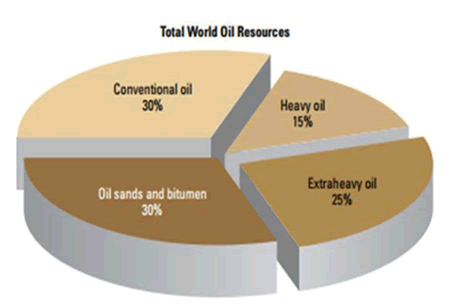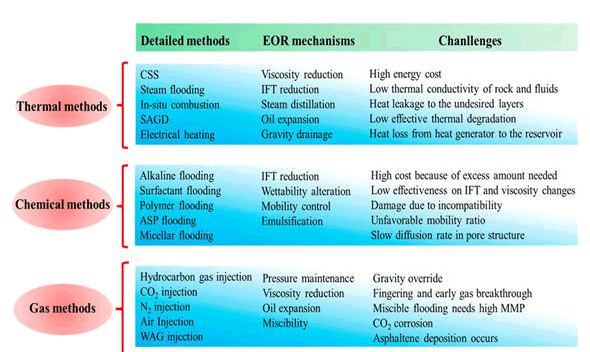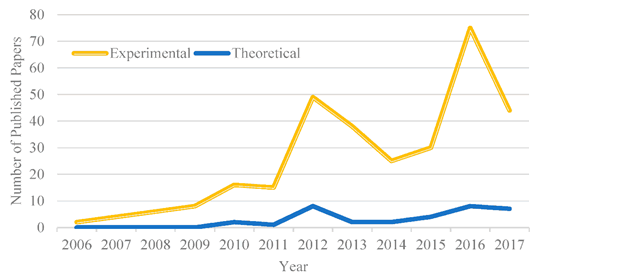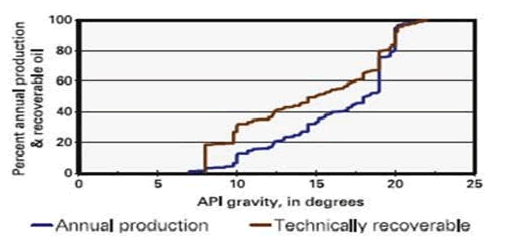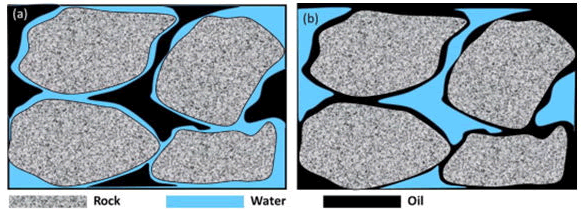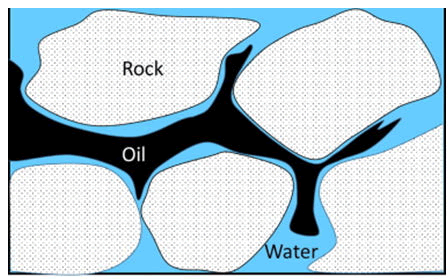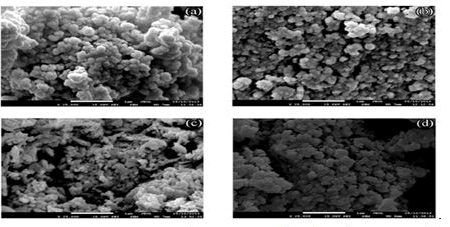Enhanced Oil Recovery of Heavy and Light Oil Using Nanoparticles-A Review
Bariya Khan, Hassan Aziz
1Department of Petroleum and Gas Engineering, Dawood UET, Karachi, Pakistan
2Department of Petroleum and Natural Gas Engineering, Mehran UET, Jamshoro, Sindh, Pakistan
- *Corresponding Author:
- Bariya Khan Department of Petroleum and Gas Engineering, Dawood UET, Karachi, Pakistan Tel: 923443816390 E-mail: bryakhan13@gmail.com
Received Date: December 03,2021; Accepted Date: December 16,2021; Published Date: December 23,2021
Citation: Khan B, Aziz H (2021) Enhanced Oil Recovery of Heavy and Light Oil Using Nanoparticles-A Review. Nano Res Appl Vol:7 No:11
Abstract
Since with the depilating resources of hydrocarbons, the more focus is towards unconventional reservoirs like heavy oil and shale reserves. In the past period time, the crude oil requirement has been raised extensively worldwide, which is a result of stressing the supply of conventional oil. Enhanced oil recovery procedures are applied to the reservoirs to recover a surplus amount of oil which is not able to recover by secondary method such as water flooding and gas injection. In the current scenario where available reserves of hydrocarbons are declining the attention is towards EOR techniques especially towards nanotechnology. This paper has presented an overview of recent researches on the use of nanoparticles in oil and gas, especially for Enhanced Oil Recovery (EOR) techniques. The first half of the paper discusses different EOR techniques exhibited in the oil and gas sector. Further, it addresses the use of Nanotechnology in the petroleum sector by covering the potential of nanoparticles in recovery, mechanism of production. The last part of this paper focuses on the reduction of interfacial tension and wettability alteration with the help of nanoparticles. Finally, there are some conclusions that are drawn from a number of researches which include the challenges and opportunities for future researches in the field of Enhanced Oil Recovery (EOR) using nanoparticles. It highlights that SiO2, Al2O3,TiO2, ZrO2 nanoparticles are the most widely used nanoparticles for the reduction of interfacial tension and wettability alteration. With the help of nanofluids induction, many problems faced by EOR are able to solve. With numerous benefits of using nanoparticles in the oil and gas sector, there are some challenges too, which include it’s more expensive to use and their implication in the specified sector. For futuristic outlook cheaper means of nanoparticles should be introduced such as nanoclays.
Keywords
Nanoparticles; Nanotechnology; Enhanced Oil Recovery (EOR); wettability Alteration; Interfacial Reduction (IFT)
Introduction
With the advancement of technology, the world is getting revolutionized day by day. At the starting of the third decay of the 21st century, the oil and gas sector is bearing much resistance from the public sector due to environmental concerns related to fuel generation. After all, arising issues oil and gas industry will keep its place in the oil and gas sector [1]. With the innovation of technology and rapid increase in the population the demand for sustainable energy has also approached its peak [2]. Hydrocarbons are natural resources that cannot be renewed and regenerated. In the recent years of growth of the world economy, the petroleum industry has set off the most important asset for the country’s economic survival [3]. The persistent increment of the energy demand of the world due to the development of the economy and steady growth of population has been noted in the current years due to which accessibility of petroleum resources has been a decline. The resources were mainly collected from the conventional oil reserves. Unconventional oil resources are mainly consisting of Heavy oil and Extra-heavy oil that signifies an entire share of the world’s reserves. Several oil companies are interested in the exploration of unconventional reserves to use them as a substitute for the supply of energy [4]. In the previous time, the crude oil requirement has been raised extensively worldwide which in result stressing the need of the supply of convention Oil. This has been directed the situation towards preferring the substitute for adequate utilization of energy sources specifically for the supply of heavy crude oil for temporary and long-term needs. In refineries the heavy oil has been used as a feedstock for a long time, typically it is used with the combination of more conventional feedstock but has been charged at lower prices due to the less good quality as compared to conventional resources. The nature of heavy oil is more viscous as compared to other types, it also has a higher percentage of presence of Sulphur. Due to its nature, it is difficult to recover easily in operations. Because of the presence of Sulphur and its higher viscosity nature, it is complicated in recovery and it also increases the expense of refining the oil. Usually, Heavy oil is located on the margins of geological basins, it has also been assumed that heavy oil is the remains of the preexisting light oil which have lost the components of molecular weight due to decaying by bacteria, seasonal changes, and evaporation [5]. Light oil is less dense and can freely flow at room temperature, the API gravity and viscosity are low as compared to heavy oil. Heavy crude oil receives a higher price in commodity markets. Heavy oil extraction is a completely different procedure on the ground of its extraction, environmental challenges, and its marketing. For the recovery of hydrocarbons, there is numerous method which is being followed according to the requirement. Enhanced Oil Recovery (EOR) procedures applied in maximum reservoirs in the whole world to recover a surplus amount of oil that is not be recovered by a secondary and primary recovery which includes water flooding and gas injection. A global figure such as statistics result of problem reserves has shown a large segment of hydrocarbon remain identified it’s also being acknowledged that due to low recovery efficiency process (primary, secondary) also due to the deficiency of assessable technology and favorable economic conditions. In conventional reserves, the unrecovered oil also has the favorable quality of use present but it also exceeds half of the Initial Oil In Place (IOIP). Besides this, the recovery from unconventional reserves and tight shale oil formations is relatively low. It is estimated from the energy information administration, that 300 billion barrels of oil remain unexploited. As a result, EOR methods have been working as the tertiary process is a procedure used to recover untapped hydrocarbons at the possible amount in accordance with the technological economic expense [7]. The dispersion of the world’s assets is portrayed in figure 1 conventional oil at 30%, heavy oil at 15%, extra-heavy oil at 25%, oil, sand, bitumen at 30%. As heavy oil contains a large number of reserves so it is promising to recover and utilize it [8].
Figure 1: World Reserves data [9].
Heavy oil is a massive resource of hydrocarbons, most of the time it remains unexplored due to its viscous nature which results difficulties in production. Now a day there is many techniques which can help in the extraction of heavy oil, a procedure like thermal recovery, Cold Heavy Oil Production (CHOPS), chemical injection and miscible gas injection. In regard, these different techniques are combined together to produce the unique process to decrease the viscous nature of heavy oil and it is appraised as heavy because of the fact that it’s API gravity is less than 20 [10].
- Thermal Recovery.
- Carbon Dioxide Injection.
Thermal techniques
This technique is mostly used in heavy oil reservoirs where there is the involvement of heat and steam are injected in the reservoirs to lower the high viscosity of the fluid and help them to move, produce freely. According to the estimate of Dolberry Oil that the utilization of stream is 52% of the market method for Enhanced Oil Recovery (EOR), as compared to Carbon Dioxide gas injection which is 31% and Nitrogen that is 17% is being used, steam helps to provide more pressure due to which production of oil is at greater extent as the heat contributing to decreasing the hydrocarbons in the pay zone which is encircling the well. Some of the types of thermal recovery are mention below:
Hot fluid injection
In the reservoir the hot fluids are injected, such as hot water and steam in the form of super-heated and saturated which helps in reducing the viscous nature of heavy, also increases the rate of recovery.
In-situ combustion
In this procedure, oxygen and air gases are being induced in the reservoir which results, the burning part of crude oil in the formation which results increment in the quantity of the remaining oil production. This method is suggested for those hydrocarbon-bearing rocks which have good permeability, high porosity, high oil saturation, and oil of medium viscosity.
Cyclic steam
It the procedure where the single injection is involved in the reservoir which also contains 2 to 6 weeks injection of steam in the production well later it saturates of 3 to 6 days, in results the production of well is on the higher stage for multiple years and months it’s also called huff and puff method [11].
Carbon dioxide injection
The oil which is being displaced by carbon dioxide injection depends upon some mechanisms which are interconnected with the behavior of carbon dioxide the most important is the mixture of crude among these procedures the pressure and temperature of the reservoir.
Following are some of the recovery mechanisms which helps in rising the recovery in the immiscible carbon dioxide gas injection [12]
- Reduction of oil viscosity.
- Swelling of oil.
- Blowdown recovery.
- Improved injectivity.
Figure 2: The Enhanced oil Recoverey (EOR) categories [13].
All of these techniques tend to recover a large amount of oil from different mechanisms some of them are interfacial tension, change in wettability, flow control, and also includes changes in physical gravitational properties. Though it's fully shown in figure 2 all of these techniques have different issues to overcome. Like, In the methods of gasses injection which is done frequently the gas penetrates through the reservoir from the injection well and result in it stops the production of the wells in results in a left large amount of unexplored hydrocarbon beneath the surface due to high mobility ratio of injected gas and oil [13, 14].
Nanotechnology and nanoparticles
The nanoparticle which is also called nanocluster, Nano powder, and nanocrystal is an infinitesimal type of molecule which are measured at the rate of 100 nm. The research in this field has reached its peak recently because of its wide variety of applications like biomedical, optical, electronics, etc. [15]. The dictionary meaning of nanoparticles is the characterization, production, and controlling of objects in small sizes such as nanoscales. Another definition defined by National Nanotechnology Initiative (NNI) described the Technology that tried to control the matter with the least measurement of 1 to 100 nanometers in size. It is explained from the word itself, that Nano means one-billionth, therefore; it is concluded that nanotechnology derives its name from the scale which helps in generating the technology at nanometer or one-billionth of a meter [16].
Nanotechnology in petroleum industry
The applications of nanotechnology have penetrated by various regimes particularly in the petroleum industry from exploration to drilling a wellbore, its completion including the recovery process, production, and also refinery process of crude oil. The development in the field of nanotechnology is upgrading rapidly like Nano-sensors are using as a source to increase the resolution of subsurface imaging which is leading to the advancement of characterization procedures. In production, nanotechnology is also leading as it also tremendously helps in EOR techniques by advancing molecular and manipulating characteristics like interfacial tension, in addition, it also provides similar novel techniques to improve the post-production process [17]. There are numbers of studies related to nanotechnology associated with the petroleum discipline which has been thriving rapidly in figure 3 it can be seen that a large variety of studies and researches has been going hand in hand even at the downfall of the petroleum industry. In particular, the nanoparticles have been exceptionally compelling due to their potential applications [18].
Figure 3: Representation of researches on nanotechnology application in the past years [18].
Use of nanoparticles in oil recovery
The application of nanotechnology has been a valuable methodology in terms of oil production. The purpose of the study of nanoparticles is to explore the outcomes of nanofluids (nanofluids is a type of fluid containing nanometer-sized particles, called nanoparticles) [19, 64]. By following the recovery of hydrocarbon the preparation of nanofluids takes place by the misting of pure and mixed nanoparticles, i.e. Silicon oxide (SiO2), Aluminum oxide (AlO2), Nickle oxide (NiO2), and Titanium Oxide (TiO2) at the rate of opposed concentrations to the saline water.Thepre-pared nanofluids are first investigated to decide the appropriate type for the heavy oil and also for those rock samples that are subjected to study [20]. The API gravity of heavy oil is between the scale of 10 to 20, It’s viscosity is more as compare to conventional hydrocarbons and it also is capable of being in the state of liquid, consequently have the mobility ratio in the reservoir. The recovery of heavy oil can also be done by following the techniques of enhanced oil recovery for conventional oil [21]. Nanoparticles are being capable of changing particular factors in the reservoir on the other hand oil properties can take advantage of enhancing recovery. It also includes the injection of these nanoparticles in the formation and also investigates their effects on oil recovery of heavy oil [17]. At present, exploration companies are selecting accumulations of heavy oil that are of better quality. According to researches that about 66 percent of heavy oil produced on annual basis is lighter whose API gravity is less than 15?, on the contrary, 50 percent approximated recoverable heavy oil is denser [21].
Figure 4: Cumulative percentage of annual production (blue) and cumulative percentage of technically recoverable resources (brown) of heavy oil as a function of API gravity (Courtesy: U.S.G.S Fact Sheet 70-03, August 2003) [21].
Mechanisms of production of crude oil
In total there is 70% approximated heavy oil is present distinct of the total reserves in the world, in which 20% approximated amount is the total oil reserve of onshore heavy oil [22]. The method of transportation and development in heavy oil is progressively difficult due to a large amount presence of resin and asphaltene which become the reasons for high viscosity and density in heavy oil. Earlier the process of injection of steam, and light oil into the well, etc. were the conventional [1] methods or the primary recovery procedures to get the maximum yield of hydrocarbons with low API in the other methods, like to reduce the viscous nature of heavy oil to enhance the mobility ratio volumetrically and to enhance the sweep efficiency, [2] reducing the interfacial tension between oil and water to rise the capillary pressure and to enhance the oil displacement efficiency, [3] by replacing wettability of the rock from the state of oil-wet to water-wet to order to enhance capillary force from the resistance and motive force [23], it’s not an absolute idea as to it’s need a large amount of fuel consumption and the cost production of heavy oil is higher [24]. Its seems infeasible in terms of economy the development of heavy oil through the thermal method as it loses huge thermal loss. When superficial development of oil takes places through water flooding the recovery percentage is 5 to 10% of Initial Oil In Place (IOIP) [25], the primary basis is of deficient water flooding are mentioned below:
- The viscosity of heavy oil is higher beneath the surface, on the contrary, the poor mobility ratio in between the oil and water the effects are the significant fingering phenomenon, result in heavy oil in large amounts is stuck and trapped in the pores of the rock.
- Strong reservoir heterogeneity, the major differences of permeability among the upper and lower layers also in the same layer.
If the above two mentioned factors interact then it outcomes the prominent water fingering phenomenon with adverse water flooding efficiency. It’s a likely method to reduce the viscosity to enhance the development efficiency of the heavy oil reservoir, viscosity reducer is the major factor in the transportation and development of heavy oil [26,27]. The recovery factor of production can be increased by following a potential recovery mechanism. This method should be selected based on the reservoir characteristics and according to the energy system of the well [28]. Improved Oil Recovery (IOR) comprises Enhanced Oil Recovery (EOR) procedures, the incorporation of advanced drilling techniques, and well technologies. The innovative reservoir management and control system, latest monitoring techniques also with the intelligent enhancement process for the primary and secondary recovery procedures [29].
Eor recovery mechanisms using nanoparticles by altering wettability and interfacial tension
There are a number of studies that have been proven that nanoparticles are the potential agents to change the state of hydrocarbons like as increasing the oil recovery of heavy oil from the reservoir by changing the wettability of rock to the water-wet state by wettability, by lowering the interfacial tension.
Wettability
It’s an ability of the fluid to adhere and spread on the surface that is solid in the presence of immiscible fluid [30,64]. The effects of wettability could be observed in relative permeability curves, capillary pressure, and water saturation of irreducible, reducible oil saturation, oil displacement, and dispersion. These factors help in the recovery process and the productivity of the reservoir. It’s very important to know the value of the connection between capillary pressure, wettability, and the distribution of fluid between the pore spaces of the rock for the optimization of oil recovery. Connections like these in the Crude Oil Brine Rock (COBR) system are complex because of the structure of the rock and its mineralogy [31].
Figure 5: Distribution of fluids in (a) water wet (b) oil-wet rock [31].
Wettability alteration using nanoparticles
| S. No# | NP’s | Temperature (Co) | API Gravity | Dispersion Media | The contact angle of clean rock | Contact angle after treatment | Reference |
|---|---|---|---|---|---|---|---|
| SiO2 | 25 | 29.56 | Propanol | 134 | 82 | 35 | |
| SiO2 | Aa | 27.30 | Water | 122 | 24 | 36 | |
| SiO2 | 23 | 33.53-27.43 | Ethanol | 135.5 | 66 | 37 | |
| SiO2 | 26 | - | H2O | 90 | 26 | 38 | |
| SiO2 | 40 | - | H2O | 87 | 25 | 38 | |
| SiO2 | 50 | - | H2O | 83 | 21 | 38 | |
| SiO2 | 60 | - | H2O | 82 | 18 | 38 | |
| Al2O3 | 25 | 29.56 | Propanol | 134 | 90 | 35 | |
| Al2O3 | 26 | - | H2O | 90 | 71 | 38 | |
| Al2O3 | 40 | - | H2O | 87 | 66 | 38 | |
| Al2O3 | 50 | - | H2O | 83 | 65 | 38 | |
| Al2O3 | 60 | - | H2O | 82 | 61 | 38 | |
| Fe2O3 | 25 | 29.56 | Propanol | 134 | 98 | 35 | |
| TiO2 | 26 | - | H2O | 90 | 57 | 38 | |
| TiO2 | 40 | - | H2O | 87 | 52 | 38 | |
| TiO2 | 50 | - | H2O | 83 | 49 | 38 | |
| TiO2 | 60 | - | H2O | 82 | 46 | 38 | |
Table 1: Contact angle data of various Nanoparticles.
Basically, wettability alteration means changing the wettability of the reservoir from oil-wet to more water-wet [32, 64]. Determination of wettability of solids could be detected by using contact angle measurement, surface image test, sudden imbition, and zeta potential measurements. The measuring instruments which help provide the details in the rock properties due to the alteration of wettability are scanning electron microscopy, atomic force microscope, and nuclear magnetic resonance spectroscopy. A thorough investigation of surfactants has been done for wettability alteration [33, 34]. Researches also have proved wettability alteration by using nanoparticles alone or accompanied with surfactants. The factors on which the wettability alteration depends while using nanoparticles are the nature of the reservoir, hydrophobicity, and also nature and concentration of nanoparticles. The characteristics of nanoparticles are most important for rock-bearing hydrocarbons.
Aa = Ambient temperature.
Interfacial tension (ift)
The simultaneous presence of immiscible fluids like crude oil and water in oil reservoirs causes interfacial tension force (IFT). Interfacial force is the type of energy that pushed the molecules towards the surface through the large phase per unit area and is measured in dynes/cm (milli-Newtons /meter). IFT can also be used to determine the movement and distribution of fluids in porous media. Therefore, Interfacial Tension has the potential to influence the efficiency of hydrocarbons in the reservoir. It’s hard to find the interfacial tension between oil/brine or oil/injected fluids for the estimation of Enhanced Oil Recovery(EOR) techniques [39].
Other physical properties like density, mobility control and reduction of viscosity in heavy oil are measured and alter according to requirement. In addition, the chemical process is bounded by higher prices of chemicals, losses of chemicals, and possible formation damages [40,41]. Hence economical, proficient, and ecological EOR techniques are required. Nanoparticles offer a novel way to these challenges [42]. Nanoparticles have more characteristics as compared to chemical and injection fluids which are used in the typical EOR processes like gas, water. The most difficult challenge in chemical methods is the pore plugging and the increasing injection cost and reduction in permeability are caused by the injected fluids that being trapped in porous media [43]. Some of the most frequently used nanoparticles are SiO2, TiO2 and Al2O3 with sizes of 1 nm-100 nm, which is so small in contrast to pore and throat sizes [17].
Interfacial tension reduction using nanoparticles
Interfacial tension is the most efficient factor in Enhanced Oil Recovery with nanoparticles. IFT also contributes to decreasing the capillary force, consequently increasing the recovery of oil. Several types of researches have shown the reduction between oil and aqueous phase upon mixing with nanofluids to enhance the oil recoveries [44,45,46]. The droplets of oil that are being trapped have been distorted while the interfacial tension between the oil and aqueous phase is being reduced, and it may easily pass through the pore throats [44, 47].
| S.No# | NP’s | NP’sConcentrationon(wt. %) | API Gravity | DispersionMedia | Surfactant Concentration (wt. %) | IFT without NP’s (mN/m) | IFT with NP’s | References |
|---|---|---|---|---|---|---|---|---|
| 1 | SiO2 | 0.3 | 29.56 | Propanol | 0 | 38.5 | 1.45 | 35 |
| 2 | SiO2 | 0.1 | 27.30 | Water | 0 | 13.62 | 10.69 | 36 |
| 3 | SiO2 | 0.1 | 33.53-27.43 | Ethanol | 0 | 25 | 5 | 37 |
| 4 | SiO2 | 0.05 | 38 | Brine | 0 | 19.2 | 16.9 | 47 |
| 5 | SiO2 | 0 | 33.53-27.43 | Brine | 0.5 | 21.7 | 4.2 | 48 |
| 6 | SiO2 | 0.1 | 33.53-27.43 | Brine | 0.5 | 21.7 | 4.5 | 48 |
| 7 | SiO2 | 0.5 | 33.53-27.53 | Brine | 0.5 | 21.7 | 5.2 | 48 |
| 8 | SiO2 | 1.0 | 33.53-27.53 | Brine | 0.5 | 21.7 | 5.8 | 48 |
| 9 | SiO2 | 1.5 | 33.53-27.53 | Brine | 0.5 | 21.7 | 6.1 | 48 |
| 10 | SiO2 | 2.0 | 33.53-27.53 | Brine | 0.5 | 21.7 | 6.3 | 48 |
| 11 | Al2O3 | 0.3 | 29.56 | Propanol | 0 | 38.5 | 2.25 | 35 |
| 12 | Fe2O3 | 0.3 | 29.56 | Propanol | 0 | 38.5 | 2.75 | 35 |
| 13 | ZrO2 | 0.01 | 21.2 | Water | 0.2 | 16 | 3.1 | 49 |
| 14 | ZrO2 | 0.01 | 21.2 | Water | 0.3 | 18.4 | 5.4 | 49 |
| 15 | ZrO2 | .001 | - | Water | 0 | 51.4 | 37.2 | 50 |
| 16 | ZrO2 | 0.01 | - | Water | 0 | 51.4 | 37.2 | 50 |
| 17 | ZrO2 | 0.1 | - | Water | 0 | 51.4 | 36.8 | 50 |
Table 2: Summary of nanoparticles effects on interfacial tension IFT.
Summary of nanotechnology methods in enhanced oil recovery (eor)
| Serial No# | Nanoparticles | Principal findings | References |
|---|---|---|---|
| Aluminum oxide (Al2O3) | Al2O3 is widelyused in EOR procedures. It is an active agent in the reductionof interfacial tension of oil brine. It also helps to decreases the oilviscosity. | 51,17 | |
| Iron oxide | It has distinctive magnetismcharacteristics. Helps in the reduction of oil viscosity. | 52,53 | |
| Nickel oxide (Ni2O3) | It contains the same properties as AL2O3have. | 54 | |
| Magnesium Oxide (MgO) | Because of its permeability decrease insandstone rocks. Its viscosity decrees when soaked thesample of rock in ethanol with MgO. | 54 | |
| Zinc oxide (ZnO) | It is used at a minimum in EORprocedures. They can block the pores to presentnegative results. | 54 | |
| Zirconium oxide (ZrO2) | Very limited use in EOR. It shows a little recovery of oil incontrast to distilled water alone. | 55 | |
| Tin oxide (SnO2) | It has the same characteristics as thatof ZrO2. Increase recovery of oil while spreadingin distilled water. | 55 | |
| Titanium dioxide (TiO2) | Has the ability to recover 80% of oilfrom oil-wet Berea sandstone. It also decreases the oil-brineInterfacial Tension. Attain a large recovery of oil in wetformation as compared to SiO2. | 51,56 | |
| Multiwall Carbon nanotubes (MWNT) | It can recover 36% of oil due to theabsence of Electromagnetic waves. On the contrary, the presence ofElectromagnetic waves presents 72% of the recovery of oil. | 57,58 | |
| Silica oxide (SiO2) | Limited recovery of oil at roomtemperature. Recognized as one of the widely used Npfor EOR methods in different conditions of wettability. Some of its abilities are the formationof stable form, stable bubbles penetration further inside the pores whichhelps to displace more amount of oil. | 20,59,60,48,61 | |
| Hydrophobic Silicon oxide (SiO2) | It helps to reduce the chance of blockingthe pore spaces in EOR procedures due to its small size which ranges fromseveral ten thousand nanometers. | 54,51 | |
| Inorganic silica core or polymer shell nanocomposite | It also an active agent of reduction ofIFT. Increase viscosity at critical concentration. Can be an exemplary EOR agent forsandstone reservoirs, especially when dispersing in ethanol. | 62,63 |
Conclusions
As the population of the world increasing the energy demand is also at its highest stage. Market demand is also increasing day by day; the requirement of a conventional oil is harder to meet now as compared to then. The energy resources are also depleted due to climate change, although light oil reservoirs are meet exploring a large amount of heavy oil is remaining unexplored due to its viscous nature, it's channeling from subsurface to above at ground to solve all these innovative techniques has to follow to mitigate the gap between supply and demand. It’s better to exploit heavy oil reserves instead of expending a large amount on the exploration of remote basins of light oil. With this concern, people are seeking new technologies to explore heavy oil to increase the ultimate recovery from these hydrocarbons. Nanotechnology in Enhanced Oil recovery could be a game-changer for many countries if it’s used and its prospects are very high. Some many excellent investigations and researches have been done in the field of Nanoparticles in EOR but not a single field trial has been reported on a large scale. Some of the conclusion that can be taken from this review are:
- EOR is the method that is used to perform to create a clear flow ability of well in the reservoir by injecting water, polymers -surfactants gases, and nanoparticles. It also helps to produce an extra amount of oil which have been stuck in the pore throat after primary and secondary recoveries.
- Nanoparticles have a great impact on wettability and interfacial tension. It can be seen from Table 1 and Table 2 that these nanoparticles have been dispersed in different aqueous phases and each has different characteristics such as water, ethanol, brine and showed higher EOR performances.
- Silica (SiO2) nanoparticles are the most observed one which has great ability to alter the wettability. Aluminum oxide (Al2O3) is also the new and widely used NP to change the interfacial tension of oil. Titanium dioxide (TiO2) and Zirconium Oxide (ZrO2) are also the focused nanoparticles but they are less active as compare to SiO2 and Al2O3.
- The number of a parameter depends on effective nanoparticle performance such as Nanoparticles size, its type, its concertation, its temperature, or its characteristics that either is favorable for the reservoir or not.
- With all these benefits and high-performance results, nanoparticles are higher in prices and it is not economical most of the time that may be a reason why it isn’t executed on the larger level but if polymer and nanoparticles are used at the same time then it's feasible. As polymers have the potential of sweep efficiency of chemicals and when it combined with novel techniques of nanoparticles which can alter wettability and interfacial tension then it can create a breakthrough in EOR techniques.
- The futuristic outlook in terms of nanoparticles would be the cheap use of nanoparticles like nanoclays.
References
- Robert J Johnson, Reed Blakemore, Randolph Bell “The role of oil and gas companies in the transition
- Marepallyxc B C, Ampelli C, Genovese C, Quadrelli E A, Perathoner S, et al. (2019) Production of solar fuels using CO2. Stud Surf Sci Catal 178:7-30
- Guo E, Ju M, & Gong N (2011) Development of Chinese strategic petroleum reserves base on comparable research about Japanese situation and policies. Energy Procedia 5:2262-2270
- Santos R G, Loh W, Bannwart A C, & Trevisan O V (2014) An overview of heavy oil properties and its recovery and transportation methods. Braz. J Chem Eng 31:571-590
- Speight J G (2013) Heavy oil production processes. Gulf Professional Publishing
- Canadian Association of Petroleum Producers. 2009. Alken Murray Corp. 1999
- Satter A, & Iqbal G M (2016) 17-Enhanced oil recovery processes: thermal, chemical, and miscible floods. Reserv Eng 313-337
- Shah R D (2009) Application of nanoparticle saturated injectant gases for EOR of heavy oils. In SPE annual technical conference and exhibition. Soc Pet Eng
- Gangoli N, & Thodos G (1977) Enhanced Oil Recovery Techniques—State of the Art Review. J Can Petrol Technol 16:13-20
- Klins M A, & Ali S M (1982) Heavy oil production by carbon dioxide injection. J Can Pet Technol 21
- Souza J C, Cursino D F, & Pádua K G (2005) Twenty years of steam injection in heavy-oil fields. In Proceedings of the SPE Latin American and Caribbean Petroleum Engineering Conference, Rio de Janeiro. Brazil 20-23
- Ahmadi Y, Eshraghi S E, Bahrami P, Hasanbeygi M, Kazemzadeh Y, et al. (2015) Comprehensive Water–Alternating-Gas (WAG) injection study to evaluate the most effective method based on heavy oil recovery and asphaltene precipitation tests. J Pet Sci Eng 133:123-129
- Sun X, Dong M, Zhang Y, & Maini B B (2015) Enhanced heavy oil recovery in thin reservoirs using foamy oil-assisted methane huff-n-puff method. Fuel 159:962-973
- El-Diasty A I, & Ragab A M S (2013) Applications of nanotechnology in the oil & gas industry: Latest trends worldwide & future challenges in Egypt. In North Africa Technical Conference and Exhibition. Soc Pet Eng
- Zhang T (2012) Modeling of nanoparticle transport in porous media (Doctoral dissertation)
- Taylor R, Coulombe S, Otanicar T, Phelan P, Gunawan A, et al. (2013) Small particles, big impacts: A review of the diverse applications of nanofluids. Int J Appl Phys 113:1
- Alomair O A, Matar K M, & Alsaeed Y H (2014) Nanofluids application for heavy oil recovery. In SPE Asia Pacific oil & gas conference and exhibition. Soc Pet Eng
- Agista M N, Guo K, & Yu Z (2018) A state-of-the-art review of nanoparticles application in petroleum with a focus on enhanced oil recovery. Appl Sci 8:871
- Speight J G (2013) Enhanced recovery methods for heavy oil and tar sands. Elsevier
- Ogolo N A, Olafuyi OA, & Onyekonwu M O (2012) Enhanced oil recovery using nanoparticles. In SPE Saudi Arabia section technical symposium and exhibition. Soc Pet Eng
- Meyer R F, & Attanasi ED (2003) Heavy oil and natural bitumen-strategic petroleum resources. World 434:650-657
- Ren Y & Wang J G (2001) Theory and practice of the thermal recovery of the heavy oil and high-pour point oil
- Zhang F, Ouyang J, Feng X, Xu L & Lin H (2011) A chemical agent enhancing recovery of the heavy oil reservoir. In SPE Enhanced Oil Recovery Conference. One Petro
- Sun J, Ran Q, & Shi H (2005) Water-flooding characteristic and effect evaluation of the fractured volcanic heavy oil reservoir of Zao 35 block in the Dagang oilfield. Petroleum Geology and Recovery Efficiency 1:59-62
- Huizhuan Z F X, & Lijian D (1999) The Application Of Pour Point Depessant/Viscosity Reducer In Production And Trasportation For Crude Oil [J]. Speciality Petrochemicals 6
- Fayang J, Wanfen P, & Zhaogang R (2005) Experimental study of viscosity reduction by water flooding for heavy oil. Special Oil & Gas Reservoirs 12:95-97
- Thomas S (2008) Enhanced oil recovery-an overview. Oil & Gas Science and Technology-Revue de l'IFP 63:9-19
- Alvarado V & Manrique E (2010) Enhanced oil recovery: an update review. Energies 3:1529-1575
- Temizel C, Kirmaci H, Inceisci T, Wijaya Z, Zhang M, et al. (2016) Production Optimization in Heavy Oil Recovery Processes. In SPE Heavy Oil Conference and Exhibition. Soc Pet Eng J
- Lau H C, Yu M, & Nguyen Q P (2017) Nanotechnology for oilfield applications: Challenges and impact. J Pet Sci Eng 157:1160-1169
- Khalil M, Jan B M, Tong C W & Berawi M A (2017) Advanced nanomaterials in oil and gas industry: design, application and challenges. Applied energy 191:287-310
- Mohammed M & Babadagli T (2015) Wettability alteration: A comprehensive review of materials/methods and testing the selected ones on heavy-oil containing oil-wet systems. Adv. Colloid Interface Sci 220:54-77
- Hou B F, Wang Y F & Huang Y (2015) Mechanistic study of wettability alteration of oil-wet sandstone surface using different surfactants. Applied Surface Science 330:56-64
- Salehi M, Johnson S J & Liang JT (2008) Mechanistic study of wettability alteration using surfactants with applications in naturally fractured reservoirs. Langmuir 24:14099-14107
- Joonaki E, & Ghanaatian S J P S (2014) The application of nanofluids for enhanced oil recovery: effects on interfacial tension and coreflooding process. Pet Sci Technol 32:2599-2607
- Moradi B, Pourafshary P, Jalali F, Mohammadi M, & Emadi M A (2015) Experimental study of water-based nanofluid alternating gas injection as a novel enhanced oil-recovery method in oil-wet carbonate reservoirs. J Nat Gas Sci Eng 27:64-73
- Roustaei A, Saffarzadeh S, & Mohammadi M (2013) An evaluation of modified silica nanoparticles’ efficiency in enhancing oil recovery of light and intermediate oil reservoirs. Egypt J Pet 22:427-433
- Esfandyari Bayat A, Junin R, Samsuri A, Piroozian A, & Hokmabadi M (2014) Impact of metal oxide nanoparticles on enhanced oil recovery from limestone media at several temperatures. Energy & fuels 28:6255-6266
- Ahmadi M A, & Shadizadeh S R (2017) Nano-surfactant flooding in carbonate reservoirs: A mechanistic study. Eur Phys J Plus 132:246
- Chang H L, Zhang Z Q, Wang Q M, Xu Z S, Guo Z D, et al. (2006) Advances in polymer flooding and alkaline/surfactant/polymer processes as developed and applied in the People's Republic of China. J Pet Technol 58:84-89
- Vargo J, Turner J, Bob V, Pitts M J, Wyatt K, et al. (2000) Alkaline-surfactant-polymer flooding of the Cambridge Minnelusa field. SPE Reserv. Evaluation Eng 3:552-558
- Krishnamoorti R (2006) Extracting the Benefits of Nanotechnology for the Oil Industry. Soc Pet Eng J
- Ahmadi M, Habibi A, Pourafshari P, & Ayatollahi S (2011) Zeta potential investigation and mathematical modeling of nanoparticles deposited on the rock surface to reduce fine migration. In SPE Middle East Oil and Gas Show and Conference. Society of Petroleum Engineers
- Shahrabadi A, Bagherzadeh H, Roostaie A, & Golghanddashti H (2012) Experimental investigation of HLP nanofluid potential to enhance oil recovery: A mechanistic approach. In SPE International Oilfield Nanotechnology Conference and Exhibition. Society of Petroleum Engineers
- Onyekonwu M O, & Ogolo N A (2010) Investigating the use of nanoparticles in enhanced oil recovery. In 34 th Annual SPE International Conference and Exhibition, Tinapa, Calabar, Nigeria
- Zaid, Hasnah Mohd, Noorhana Yahya, and Noor Rasyada Ahmad Latiff (2013)"The effect of nanoparticles crystallite size on the recovery efficiency in dielectric nanofluid flooding" J Nanopart Res 21:103-108
- Hendraningrat L, & Torsæter O (2014) Effects of the initial rock wettability on silica-based nanofluid-enhanced oil recovery processes at reservoir temperatures. Energy & Fuels 28:6228-6241
- Sun Q, Li Z, Li S, Jiang L, Wang J, et al. (2014) Utilization of surfactant-stabilized foam for enhanced oil recovery by adding nanoparticles. Energy & Fuels 28:2384-2394
- Mohajeri M, Hemmati M, & Shekarabi A S (2015) An experimental study on using a nanosurfactant in an EOR process of heavy oil in a fractured micromodel. J Pet Sci Eng 126:162-173
- Esmaeilzadeh P, Hosseinpour N, Bahramian A, Fakhroueian Z, & Arya S (2014) Effect of ZrO2 nanoparticles on the interfacial behavior of surfactant solutions at air–water and n-heptane–water interfaces. Fluid Phase Equilibria 361:289-295
- Hendraningrat L, & Torsaeter O (2014) Unlocking the potential of metal oxides nanoparticles to enhance the oil recovery. In offshore technology conference-Asia. Offshore Technology Conference
- Lee J H, Jang J T, Choi J S, Moon S H, Noh S H, et al. (2011) Exchange-coupled magnetic nanoparticles for efficient heat induction. Nature nanotechnology 6:418-422
- Palchoudhury S, & Lead J R (2014) A facile and cost-effective method for separation of oil–water mixtures using polymer-coated iron oxide nanoparticles. Environ Sci Technol 48:14558-14563
- Negin C, Ali S, & Xie Q (2016) Application of nanotechnology for enhancing oil recovery–A review. Petroleum 2:324-333
- Naje A N, Norry A S, & Suhail A M (2013) Preparation and characterization of SnO2 nanoparticles. Int j innov 2:7068-7072
- Ehtesabi H, Ahadian M M & Taghikhani V (2015) Enhanced heavy oil recovery using TiO2 nanoparticles: investigation of deposition during transport in core plug. Energy & Fuels 29:1-8
- Chandran K (2013) Multiwall Carbon Nanotubes (MWNT) Fluid in EOR Using Core Flooding Method under the Presence of Electromagnetic Waves
- Friedheim J E, Young S, De Stefano G, Lee J, & Guo Q (2012) Nanotechnology for oilfield applications-hype or reality. In SPE international oilfield nanotechnology conference and exhibition. Society of Petroleum Engineers
- Morrow N R (1990) Wettability and its effect on oil recovery. J Pet Technol 42:1-476
- Wang D, Han P, Shao Z, Hou W, & Seright R S (2008) Sweep Improvement Options for the Daqing Oil Field. 11:18–26
- Stocco A, Garcia-Moreno F, Manke I, Banhart J & Langevin D (2011) Particle-stabilised foams: structure and aging. Soft Matter 7:631-637
- Zhang T, Davidson D, Bryant S L, & Huh C (2010) Nanoparticle-stabilized emulsions for applications in enhanced oil recovery. In SPE improved oil recovery symposium. Society of Petroleum Engineers
- Nguyen P T, Do B P H, Pham D K, Nguyen Q T, Dao D Q P, et al. (2012) Evaluation on the EOR potential capacity of the synthesized composite silica-core/polymer-shell nanoparticles blended with surfactant systems for the HPHT offshore reservoir conditions. In SPE International Oilfield Nanotechnology Conference and Exhibition. Society of Petroleum Engineers
- Aziz H, & Tunio SQ (2019) Enhancing oil recovery using nanoparticles—A review. Advances in Natural Sciences: Nanoscience and Nanotechnology 10:033001
Open Access Journals
- Aquaculture & Veterinary Science
- Chemistry & Chemical Sciences
- Clinical Sciences
- Engineering
- General Science
- Genetics & Molecular Biology
- Health Care & Nursing
- Immunology & Microbiology
- Materials Science
- Mathematics & Physics
- Medical Sciences
- Neurology & Psychiatry
- Oncology & Cancer Science
- Pharmaceutical Sciences
